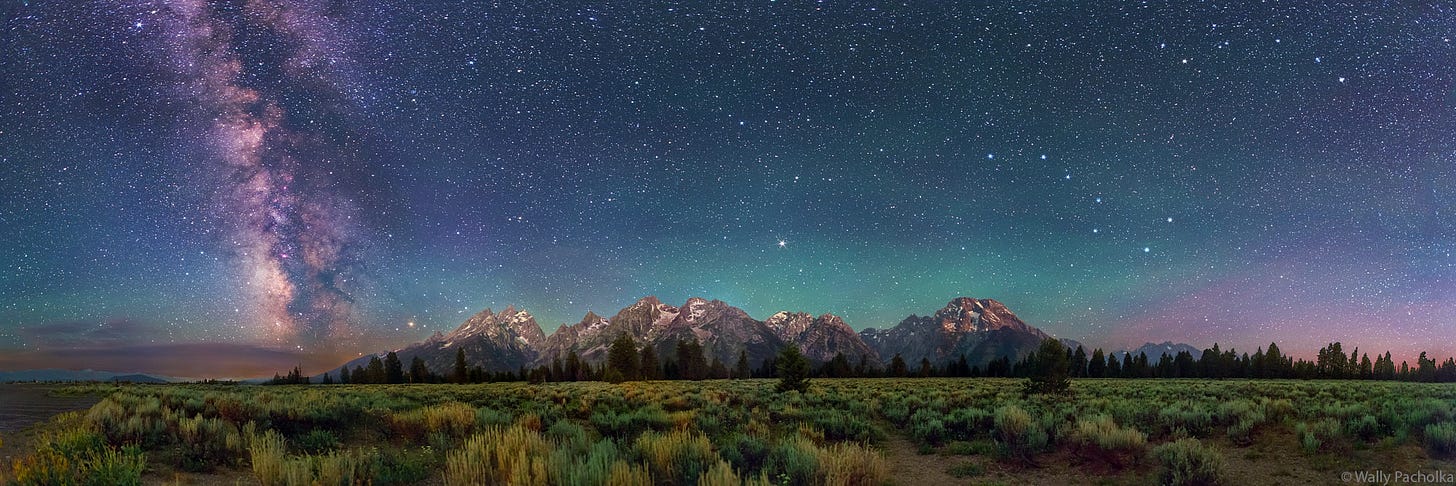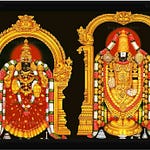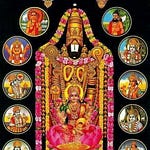Good morning! We have awoken Padmāvatī Tāyār with verses 3–4, and now it is time to begin the process of awakening Lord Veṅkaṭeśvara.
Atry-ādi-sapta ṛṣayaḥ samupāsya sandhyām Ākāśa-sindhu-kamalāni mano-harāṇi | ādāya pāda-yugam arcayituṃ prapannāḥ Śeṣâdri-śekhara-vibho! tava suprabhātam || (VSu 5)
अत्र्या-ऽऽदि-सप्त ऋषयः समुपास्य सन्ध्याम् आकाश-सिन्धु-कमलानि मनो-हराणि । आदाय पाद-युगम् अर्चयितुं प्रपन्नाः शेषाद्रि-शेखर-विभो ! तव सुप्रभातम् ॥
Completing their morning Sandhyā rites, the Seven Sages (Atri, Bhṛgu, Kutsa, Vasiṣṭha, Gautama, Kaśyapa, and Aṅgiras), have arrived, fully dedicated to You, to worship Your two feet with lotuses, utterly captivating, from the Ākāśa-Gaṅgā: O All-pervading Almighty atop Śeṣâdri, a blessed morning unto You!
There are a number of fascinating multiplicities of meaning within this verse.
On terrestrial and celestial rivers
First, there is an intentional ambiguity with the word ākāśa-sindhu, as it can have two meanings:
Terrestrially, it refers to the Ākāśa-Gaṅgā, the famous waterfall in the vicinity of Tirupati, from which the holy water for Lord Veṅkaṭeśa’s daily bathing ritual (tirumañjanam) is brought by the descendants of Tirumalai Nambi to this day.
Celestially, it can also refer to the Milky Way, which is seen as a river of stars flowing through the sky. This is clearly visible at night—or at least it used to be in pre-modern times before anthropogenic light pollution cut us off from our stellar guides. This celestial interpretation also fits with the fact that the Saptarṣi, the Seven Sages, form the Ursa Maior constellation (the Big Dipper). Thus, on this star-based account they are gathering lotuses from this divine river and bringing them down to earth.

On flowers and prayers
Next, zoom in on the specific offering that the Saptarṣi bring: kamalāni mano-harāṇi “lotuses, utterly captivating”. Both of those words should immediately alert us to the role of Padmāvatī Tāyār here:
[kamalāni] the lotuses, because Padmāvatī Tāyār Herself, the Lotus-lady, dwells in them.
[mano-harāṇi] just as Tāyār Herself was described as mano-hara-divya-mūrti in Verse 3.
The literal / terrestrial interpretation would be just that the Saptarṣi bring especially beautiful lotuses for the Lord—only the best will do for him! More poetically and more celestially, though, we do not have to limit ourselves to flowers made of organic materials. We can imagine the Saptarṣi as offering not (just) ordinary flowers, but sacred verses as if they were flowers (mantra-puṣpam). The Saptarṣi offer not just flowers but śrī-sūktis, sacred hymns from the Sanskrit Vedas and the Tamil Prabandhams. These hymns are being called lotuses because they are the dwelling-place of the Supreme Lady;1 they are manohara “captivating” because they tell us about the Divine.
On reaching and taking refuge
The Saptarṣi are also described as prapanna. This word literally means “arrived” or “reached”, but but it has a far more significant theological meaning for Śrīvaiṣṇavas: A prapanna is someone who has performed prapatti to the Supreme Divine, a full and total surrender to the Divine.
To perform prapatti is to recognize one’s fundamental ontological dependence on the Divine, to accept the Divine Couple as both the end and the means of existence, to take refuge in Their lotus-feet, and to enjoy the ultimate freedom and comfort that emerges from this joyful embrace of the Divine.
Enormous volumes have been written about this topic by the great ācāryas and it would take us far, far away from our current scope to enter into the details of prapatti.2 The main thing to note is that prapanna is a highly charged word in the Śrīvaiṣṇava context, and its presence should therefore immediately draw our attention.
On omnipotence and omnipresence
Finally, the last line in this verse will be repeated over the next few verses as well, so it is important to understand it. Again it is an invocation of Lord Veṅkaṭeśa, as located on Śeṣâdri (one of the seven hills of Tirupati), and it uses a very deep word, vibhu, to describe Him. This word has two senses:
“almighty”, “all-powerful”, “omnipotent”: This tells us that Śrīnivāsa Pĕrumāḷ, the Lord who dwells in Tirupati, is none other than the Supreme Being.
“all-pervading”, “omnipresent”: This tells us that Śrīnivāsa Pĕrumāḷ is present everywhere and everywhen (if I may invent a word).
A potential paradox
But this then raises a whole set of questions: if Śrīnivāsa Pĕrumāḷ is present everywhere and everywhen, then why should we say “All-pervading Almighty atop Śeṣâdri”? After all, He is present everywhere and not just on one particular hill-top. How can this one temple manifestation be everywhere? Why go to temples at all?
The response, I think, is best seen in the famous opening verse of the Īśôpaniṣad, which I will translate extremely simply and literally here:
pūrṇam adaḥ, pūrṇam idaṃ, pūrṇāt pūrṇam udacyate | pūrṇasya pūrṇam ādāya pūrṇam evâ ’vaśiṣyate || (ĪU 0)
That is Fullness This is Fullness From Fullness, Fullness arises Take up the Fullness of the Fullness— Fullness alone remains.
It is the very same Śrīnivāsa Pĕrumāḷ who is present wholly and completely in Tirupati in His beautiful temple icon form who is also all-pervading and who is present fully in every part of the universe. His presence in any particular manifestation does not detract from His presence elsewhere; similarly, His omnipresence does not dilute His manifestation in any particular locus.
At the same time, His presence may be more or less easily perceived by us humans in different places, and it may manifest for us differently in different places. His divine manifestation in Tirupati is thus therefore unique and uniquely charming, without in any way downplaying His other forms elsewhere.
|| Śrī-Padmāvatī-Nāyikā-sameta-Śrī-Śrīnivāsa-parabrahmaṇe namaḥ ||
As Swāmī Vedânta Deśika puts it in his Śrī-stuti:
Śeṣaś, cittaṃ vimala-manasāṃ, maulayaś ca śrutīnāṃ sampadyante viharaṇa-vidhau yasya śayyā-viśeṣāḥ || (ŚStu 5cd)
The Cosmic Serpent Ādi-Śeṣa, the thought-streams of those of immaculate mind, the crowns of the Vedas— these are Your favorite couches for rest and relaxation!
Swāmī Āḷavandār conveys the universal accessibility of prapatti beautifully in his Stotra-ratna (the verb prapadye is from the same root as the noun form prapatti):
na dharma-niṣṭho ’smi, na câ ’’tma-vedī na bhaktimāṃs tvac-caraṇâ-’ravinde | akiñcano ’nanya-gatiḥ Śaraṇya! tvat-pāda-mūlaṃ śaraṇaṃ prapadye || (StR 22)
I am not grounded in dharma, nor am I a knower of the Self, nor indeed am I filled with devotion to Your lotus-feet. I have nothing to call my own, I have nowhere else to turn: O Supreme Refuge! At Your feet do I take shelter.










Share this post